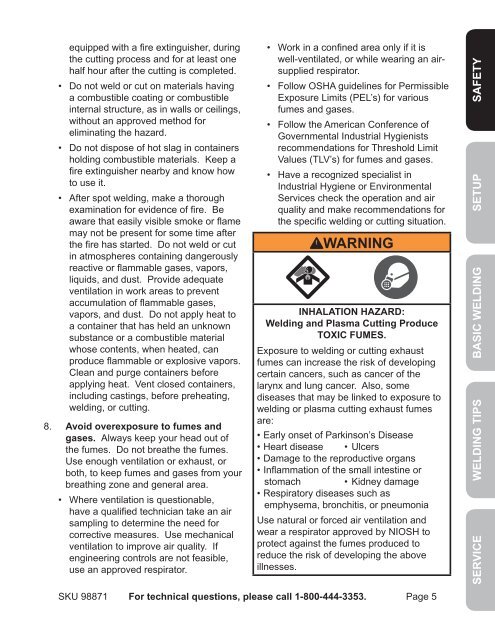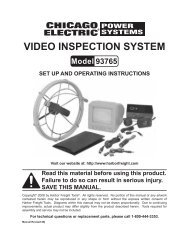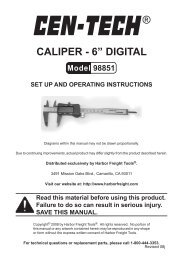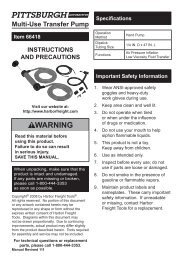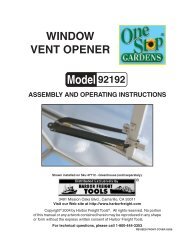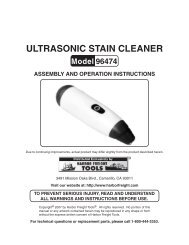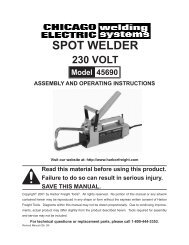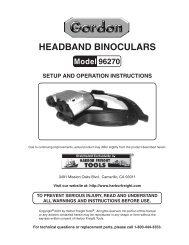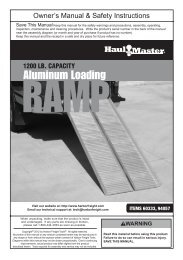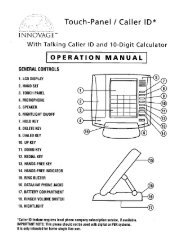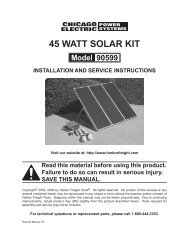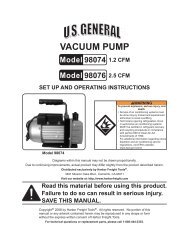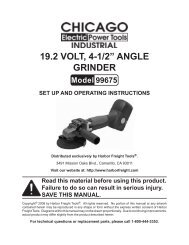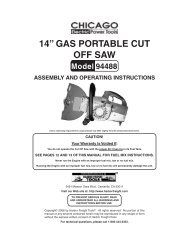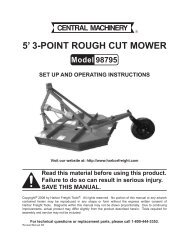90 AMP FLUX WIRE WELdER - Harbor Freight Tools
90 AMP FLUX WIRE WELdER - Harbor Freight Tools
90 AMP FLUX WIRE WELdER - Harbor Freight Tools
Create successful ePaper yourself
Turn your PDF publications into a flip-book with our unique Google optimized e-Paper software.
8.<br />
equipped with a fire extinguisher, during<br />
the cutting process and for at least one<br />
half hour after the cutting is completed.<br />
• Do not weld or cut on materials having<br />
a combustible coating or combustible<br />
internal structure, as in walls or ceilings,<br />
without an approved method for<br />
eliminating the hazard.<br />
• Do not dispose of hot slag in containers<br />
holding combustible materials. Keep a<br />
fire extinguisher nearby and know how<br />
to use it.<br />
• After spot welding, make a thorough<br />
examination for evidence of fire. Be<br />
aware that easily visible smoke or flame<br />
may not be present for some time after<br />
the fire has started. Do not weld or cut<br />
in atmospheres containing dangerously<br />
reactive or flammable gases, vapors,<br />
liquids, and dust. Provide adequate<br />
ventilation in work areas to prevent<br />
accumulation of flammable gases,<br />
vapors, and dust. Do not apply heat to<br />
a container that has held an unknown<br />
substance or a combustible material<br />
whose contents, when heated, can<br />
produce flammable or explosive vapors.<br />
Clean and purge containers before<br />
applying heat. Vent closed containers,<br />
including castings, before preheating,<br />
welding, or cutting.<br />
Avoid overexposure to fumes and<br />
gases. Always keep your head out of<br />
the fumes. Do not breathe the fumes.<br />
Use enough ventilation or exhaust, or<br />
both, to keep fumes and gases from your<br />
breathing zone and general area.<br />
• Where ventilation is questionable,<br />
have a qualified technician take an air<br />
sampling to determine the need for<br />
corrective measures. Use mechanical<br />
ventilation to improve air quality. If<br />
engineering controls are not feasible,<br />
use an approved respirator.<br />
• Work in a confined area only if it is<br />
well-ventilated, or while wearing an airsupplied<br />
respirator.<br />
• Follow OSHA guidelines for Permissible<br />
Exposure Limits (PEL’s) for various<br />
fumes and gases.<br />
• Follow the American Conference of<br />
Governmental Industrial Hygienists<br />
recommendations for Threshold Limit<br />
Values (TLV’s) for fumes and gases.<br />
• Have a recognized specialist in<br />
Industrial Hygiene or Environmental<br />
Services check the operation and air<br />
quality and make recommendations for<br />
the specific welding or cutting situation.<br />
WARNING<br />
Inhalation Hazard:<br />
Welding and Plasma Cutting Produce<br />
toxic fumes.<br />
Exposure to welding or cutting exhaust<br />
fumes can increase the risk of developing<br />
certain cancers, such as cancer of the<br />
larynx and lung cancer. Also, some<br />
diseases that may be linked to exposure to<br />
welding or plasma cutting exhaust fumes<br />
are:<br />
• Early onset of Parkinson’s Disease<br />
• Heart disease • Ulcers<br />
• Damage to the reproductive organs<br />
• Inflammation of the small intestine or<br />
stomach • Kidney damage<br />
• Respiratory diseases such as<br />
emphysema, bronchitis, or pneumonia<br />
Use natural or forced air ventilation and<br />
wear a respirator approved by NIOSH to<br />
protect against the fumes produced to<br />
reduce the risk of developing the above<br />
illnesses.<br />
Safety<br />
Service Welding Tips Basic Welding Setup<br />
SKU 98871<br />
For technical questions, please call 1-800-444-3353.<br />
Page 5


